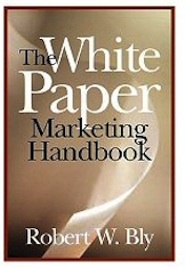Book review: The White Paper Marketing Handbook
White papers drive billions of dollars worth of technology sales every year.
Yet few people can say for sure what a white paper really is.
That’s why any new book devoted to building more understanding about white papers is welcome.
In The White Paper Marketing Handbook, renowned copywriter Bob Bly covers a lot of territory.
In fact, he ties together everything from direct mail to webinars with the concept of “edu-marketing.” I prefer the term “content marketing” but that’s a quibble.
The point is, today’s buyers are burned out on sales pitches. So the best way to engage prospects, generate trust, and draw them into your sales funnel is to give them some truly useful information.
In other words, the most effective tool for generating leads is content.
And one of the most popular pieces of content is the white paper.
This means marketers need to start thinking less like salespeople and more like publishers.
Ask yourself: What kind of unbiased information could you provide to your prospects that would help them on the job?
And how could you maximize the “halo effect” this would create, so that prospects begin to see you less as a vendor keen on selling them and more as a trusted partner interested in their success?
For those just thinking about these issues for the first time, Bly provides good guidance.
When he says that white papers are a combination of advertising and journalism, he’s right on the money.
And his list of ways to prove the assertions you make in a white paper should be tattooed on the back of every marketing manager’s hand.
Here they are again for quick reference:
- Awards
- Benchmark test performances
- Case studies
- Customer testimonials
- Design innovations
- Number of users or installed systems
- Number of years in operation
- Reviews
- Third-party endorsements
After all, just telling people you have the best technology or service is not persuasive; that’s just a sales pitch.
You have to prove it by creating a pile of credible evidence built up from the items listed here.
Because of its far-ranging content, this book will be useful to any marketing executive responsible for all the campaigns that a company launches.
On the downside, this book includes a lot of material that has nothing to do with software. Nor with white papers, for that matter.
For instance, anecdotes about marketing mouthwash, prescription drugs, and carpet cleaning may not apply to your context.
And if you’re a white paper writer, or a marketing person seeking the definitive guide to writing a white paper, you may be disappointed by the lack of specifics in this volume.
Still, Bly’s book has a lot of useful ideas, and we welcome any new resources that can help anyone understand white papers better and use them more effectively.
Copyright © Computing Technology Industry Association, Inc. Reprinted with permission.
Want to hear whenever there’s a fresh article on this site? Subscribe here to stay in the know on long-form content. From time to time, we’ll also send you word about some great new resource or training. And you can unsubscribe at any time.





